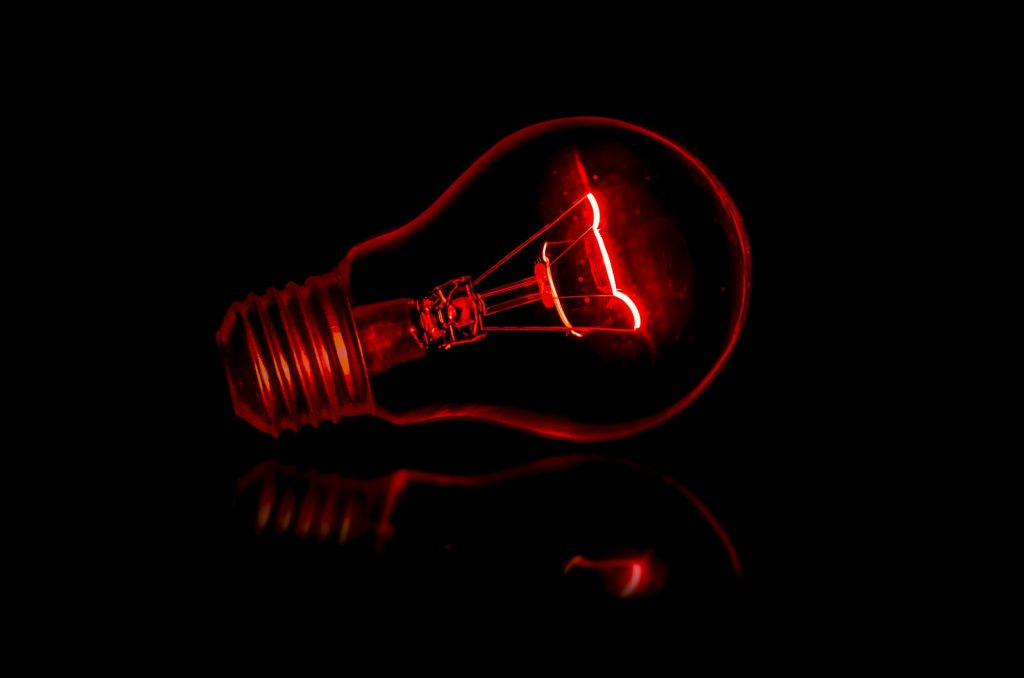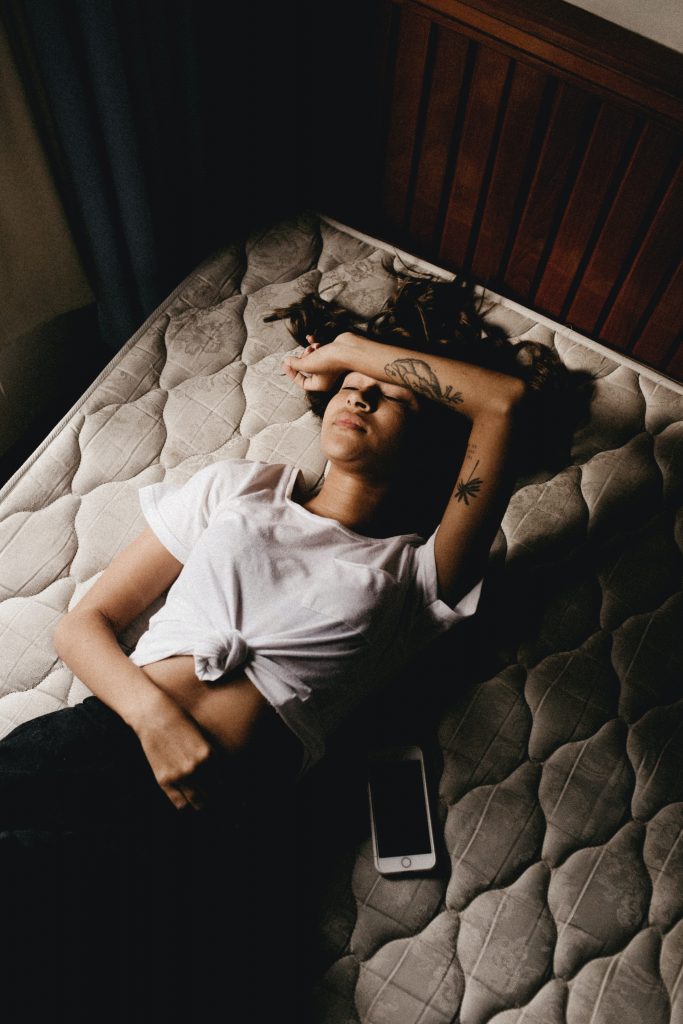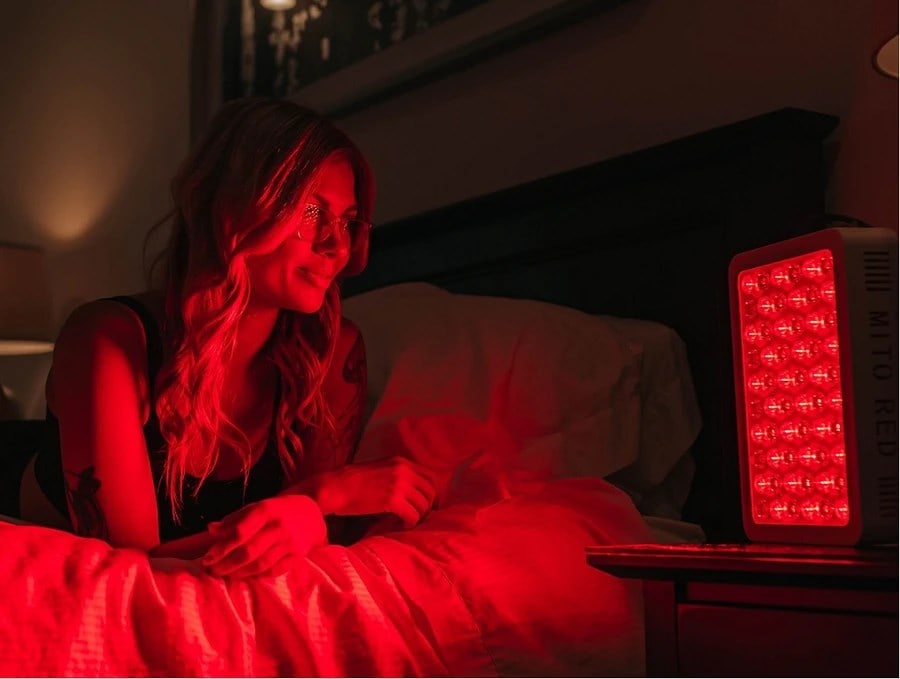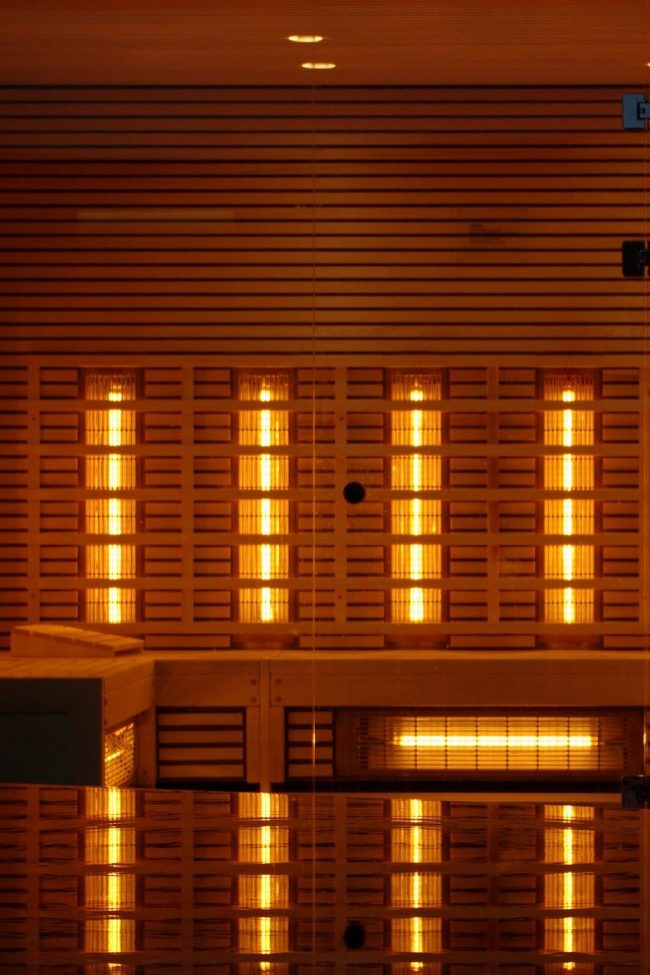Sleep directly impacts your quality of life because studies show sleep deprivation is the same as being drunk.
So in this post, I’ll look at the relationship between red light therapy and sleep to answer the question “does red light help you sleep?”. I’ll also talk about what causes sleep disorders and the adverse effects of lack of sleep.

What Causes Sleep Disorders?
Sleep regulates mood, physical performance and mental sharpness. A lack of sleep or low-quality sleep negatively affects your overall quality of life.
But red light therapy shouldn’t be your primary tool for better sleep. Instead, build healthy sleeping habits and use red light therapy to supplement these habits. Common causes behind chronic sleep deprivation include:
- Poor sleep habits
- Unregulated circadian rhythm
- Stress and anxiety
- Sleep apnea
- Medical problems like asthma
Poor Sleep Habits
The biggest reason behind sleep problems is bad habits. Although there are several unhealthy sleeping habits, here are some to look out for:
- Drinking coffee too late
- Being on your phone before bed
- Not sleeping in a dark room
Drinking coffee or any caffeinated beverage at the wrong time will wreak havoc on your sleep quality. Even if you’re able to drink coffee for dinner and fall asleep within minutes, the quality of your sleep will suffer.
Most people stop drinking coffee a few hours before bed. But caffeine has a half-life of five hours. So by sipping on coffee at 4 PM, you’ll have half the caffeine still in your bloodstream by 9 PM. An easy way to fix this is to stop drinking coffee after 2 PM.
Being on your phone before bed is another sleep killer. The blue light coming from your screen disrupts melatonin levels, so your brain thinks it’s still daytime. This makes falling asleep difficult. Install blue light blocking apps or wear blue light glasses to avoid this problem.
While sleeping, most people also aren’t in a completely dark room. There might be light coming from the street or under your door. This negatively impacts sleep quality and endurance since your room isn’t dark. Consider blackout curtains and door cushions to block all light.
Unregulated Circadian Rhythm
Another significant reason behind poor sleep is unregulated circadian rhythms. Think of your circadian rhythm as your body’s internal clock. Your body releases hormones to keep you awake when it’s day and make you sleepy when it thinks it’s night.
But with an unregulated sleep cycle, you’ll feel sleepy and energized during the wrong times of the day.
Fixing this is relatively easy. Your body loves predictability, so go to sleep and wake up at the same time every day because it offers the predictability your body’s looking for.
Stress And Anxiety
If you’re stressed and anxious before heading to bed, you’ll struggle to fall asleep. As you’re struggling, you’re more likely to scroll through social media on your phone, blocking melatonin production and making it even harder to sleep.
This is where red light therapy can help. Several studies show that sitting in front of a red light three to five times per week reduces stress and anxiety. Red light therapy does this because it’s anti-inflammatory, allowing your body to handle stress better.
Red light therapy is so powerful that it even relieves symptoms in patients with extreme depression.
Sleep Apnea
Sleep apnea is a surprisingly common condition that causes distributive breathing during sleep. Because your body isn’t getting the necessary oxygen, you wake up feeling like you never slept.
Other symptoms include:
- Dry mouth and throat
- Irritability and chronic fatigue
- Extreme headaches
- Snoring
- Episodes of no breathing during sleep
Usually, when you take a breath during sleep, air flows into your nose and down your throat into the lungs. With sleep apnea, your mouth and throat muscles relax and block airflow into your lungs. This makes getting a good night’s sleep almost impossible.
There are no clinical studies covering red light therapy and sleep apnea. So the best solution is to consult your healthcare provider and get a continuous positive airway pressure or CPAP, which allows you to breathe normally again.
Medical Problems
Several medical problems can negatively affect your sleep. These include:
- Asthma
- Chronic pain
- Heart disease
Many ashmetics find falling asleep challenging due to restricted breathing. Asthmatics may struggle with snoring, nighttime coughing, secretion and congestion. Fortunately, following your doctor’s advice alongside regular red light therapy manages these symptoms.
Another common medical problem behind lack of sleep is chronic pain. The relationship between chronic pain and red light therapy is well documented, and several studies show red light usage reduces chronic pain and inflammation.
For example, a study on patients suffering from osteoarthritis found that red light therapy lessened pain by 50 percent. This is because red light lowers inflammation and improves blood flow to damaged tissue.
Lack Of Sleep Is A Hidden Cause Of Many Health Problems
But you might be wondering how lack of sleep can cause long-term health issues. Well, here are some common adverse health effects of insufficient sleep:
- Fatigue
- High blood pressure
- Heart disease
- Obesity
- Impaired immune function

Fatigue
Fatigue is the biggest drawback to lack of sleep since it affects every aspect of life. This includes work, socializing and exercise. You might also find daily tasks exhausting, like climbing stairs and walking to the grocery store.
Fatigue is a normal response to stress and physical exertion, but if you’re tired all the time, it might mean you’re not sleeping enough, or the sleep you are getting is low-quality.
Some common symptoms include:
- Reduced physical appearance
- Constantly headaches
- Slowed reflexes
- Moodiness
- Impaired judgment and decision-making abilities
To start feeling more energized, implement all the tips mentioned above, like sleeping and waking at the same time, building good sleeping habits and avoiding blue light. To complement this, use red light therapy a few hours before bed.
Avoid sitting in front of a red light immediately before bed because it’ll raise your body temperature, making it harder to get a restful sleep in.
Instead, use your light three or four hours before bed. This allows you to experience the sleep benefits of red light without raising core body temperature.
After a few weeks of good sleeping habits and red light therapy, you’ll start to feel more energized throughout the day. If you aren’t, consult your healthcare professional since you might have underlying chronic sleep disorders like sleep inertia.
Check out our detailed Joovv Red Light Therapy Review.
High Blood Pressure
A detailed 2009 study published in the Archive of Internal Medicine followed 578 adults for over five years. They split these adults into two groups; one group slept less than six hours per night while the other slept for longer.
After five years, researchers found that the group who slept less than six hours had a 37 percent increased risk of developing high blood pressure.
This just shows the power of sleep. Lack of sleep won’t just make you feel tired the next day, but it impacts your long-term heart health.
This is also why those with undiagnosed sleep apnea have a higher risk of high blood pressure and heart disease.
So even if you can’t fit in eight hours of sleep per night, at least try for six hours since you aren’t negatively impacting your long-term health.
Heart Disease
When you’re sleeping, your body recharges and prepares for the next day. This is essential for long-term health. In the deep stages of sleep, also known as rapid eye movement or REM sleep, your heart rate slows, breathing stabilizes and blood pressure drops.
This is your heart’s way of recovering from strain.
But without proper sleep, you spend less time in REM sleep stages, giving your heart less time to recover. The inability to recover leads to problems like heart attacks, high blood pressure, cholesterol, stroke and heart disease.
Fortunately, several studies show that consistent red light therapy sessions increased ATP levels in cardiac tissue, strengthening your heart and lowering your risk of heart disease.
Obesity
If you’re looking to lose weight, sleep disturbance like bright blue light can put your weight loss goals on hold. This is due to multiple reasons:
- Fatigue leads to lack of willpower
- Your athletic performance decreases
- The stress hormone cortisol increases
A significant part of losing weight is diet. You want to stick to low-carb, nutrient-dense meals since it doesn’t spike insulin and blood glucose levels. However, if you feel tired and irritable, your willpower is much lower, and you’re more likely to binge on junk food.
You’ll also notice that your recovery ability isn’t on point when you lack sleep. This makes it harder to hit the gym constantly, affecting weight loss.
The last way lack of sleep promotes weight gain is through hormone regulation. Cortisol levels spike, and testosterone decreases, leading to an increased risk of obesity.
You may also like our guide covering Infrared Sauna Benefits!
Impaired Immune Function
Your immune system is like your body’s army. It’s essential for fighting off outside threats and infections.
But several studies show that people who get less than six hours of sleep per night are more likely to fall sick. Lack of sleep also increased the time needed to recover from infection.
Fortunately, red light therapy doesn’t just help you fall asleep. A recent 2021 study showed photobiomodulation therapy boosts your immune system to better fight off Covid-19.
Now that we know the health consequences of lack of sleep, let’s look at how different wavelengths of light affect our sleep.
How Red Light Affects Your Sleep
All light affects sleep but in different ways. And if you know which light to expose yourself to at certain times, you can set your circadian rhythm and wake up feeling energized while falling asleep at night within minutes.
Lux is a measurement of brightness, and sunlight has a brightness of 10,000 lux. Exposure to direct sunlight increases cortisol and adrenaline while lowering serum melatonin levels, making you feel energized. In comparison, office bright light only has a lux measurement of 500.
That’s why it’s essential to sit in the sun first thing in the morning because light plays as an important role in keeping fatigue away. It also tells your body it’s daytime, setting your circadian rhythm.
But this natural light exposure offers additional benefits like:
- Increased vitamin D
- Heals inflammation
- Boosts feel-good hormones like dopamine and serotonin
Artificial light isn’t as bright as the sun, but your brain perceives it differently. Blue light wavelengths block melatonin more than sunlight, you want to avoid it a few hours before heading to bed.
Red light wavelengths are longer and not stimulating and disruptive as blue light exposure. These longer wavelengths promote melatonin production, making it easier to fall asleep.

How To Use Red Light To Improve Sleep Quality
But you might be wondering how to use red light therapy for sleep? Should I do it in the morning or at night?
Use your red light panel a few hours before bed because the heat raises your core body temperature, making it harder to fall asleep. So if you’re going to bed at 10 PM, consider sitting in front of your red light at 6 PM. This way, you’re boosting melatonin production while giving your body a few hours to cool down before bed.
Dermatologists recommend doing red light therapy for 10 to 20 minutes, three to five times per week. There aren’t many benefits to super long sessions, and you’re just increasing your risk of minor burns.
Don’t forget to check out our guides to the Best Red Light Therapy Devices, Best Home Saunas and Best Sauna Blankets!
Final Thoughts On Red Light And Sleep Therapy
If you’re struggling with sleep quantity and quality, consider setting your circadian rhythm and building good sleep habits like avoiding blue light waves before bed. Use low level laser therapy as a supplement since it boosts melatonin production and offers additional benefits like improved immune function and a lower risk of developing heart issues.
Written by
Matt Gaedke
Matt is a former college basketball player turned computer engineer who discovered his passion for health and nutrition after cutting sugar from his diet in 2016. That year he founded KetoConnect with Megha in order to share their ketogenic lifestyle through recipes, videos, and educational content. Matt is always seeking to grow and try new things, a passion he shares with his wife and two amazing sons.


Leave a Comment